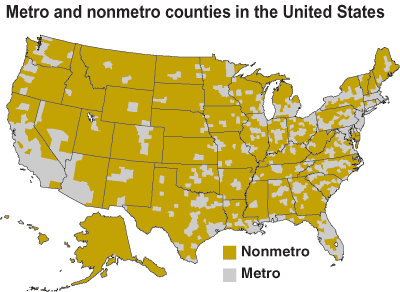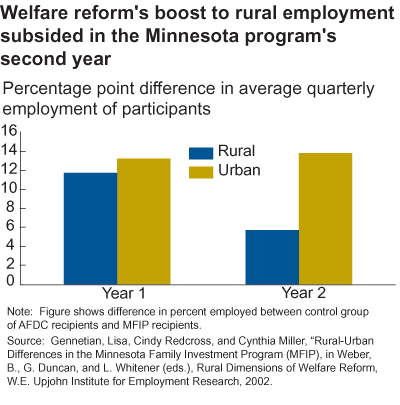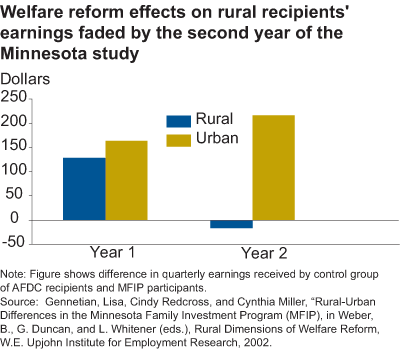Rural Welfare Reform: Lessons Learned
- by Leslie Whitener, Robert Gibbs and Lorin Kusmin
- 6/1/2003
Welfare reform legislation enacted in 1996 under the Personal Responsibility and Work Opportunity Reconciliation Act (PRWORA) dramatically altered the social safety net for poor Americans. PRWORA, designed to reduce long-term welfare dependency by increasing self-sufficiency through employment, has gone a long way toward achieving this goal. At the national level, welfare participation has declined substantially, and the employment and earnings of poor single mothers—the group most likely to receive public welfare benefits—have increased while their poverty rates have fallen.
Recent evidence suggests, however, that successful welfare reform outcomes may depend in part on where welfare recipients live. What has been the experience, for example, of the almost 8 million people living in poverty in rural America compared to central cities and suburban communities? In rural areas, employment is more concentrated in low-wage industries (see 'Low-Skill Workers Are a Declining Share of All Rural Workers”); unemployment and underemployment are greater; education levels are lower; and work support services, such as formal paid child care and public transportation, are less available. In these less favorable circumstances, how well has welfare reform worked in moving rural low-income adults into the workforce and out of poverty?
With congressional reauthorization of welfare legislation scheduled for 2003, ERS addresses two questions to inform the policy debate surrounding reauthorization: What have we learned from empirical studies about rural-urban differences in welfare reform effects on program participation, employment, and poverty? Do rural and urban low-income families have different needs that might be reflected in the design of policies meant to provide assistance?
Welfare Law Changes Dramatically
The Personal Responsibility and Work Opportunity Reconciliation Act (PRWORA) fundamentally changed the public assistance system established during the 1930s. The Act replaced the entitlement program Aid to Families with Dependent Children (AFDC) with Temporary Assistance for Needy Families (TANF), which is funded through block grants to States. TANF provides assistance and work opportunities to needy families by granting States the Federal funds and wide flexibility to develop and implement their own welfare programs. It seeks to move people from welfare to work by imposing a 5-year lifetime limit on receiving Federal welfare benefits and requiring recipients to work or seek employment within 2 years of receiving benefits. Low-income single mothers and their families are the primary recipients of TANF.
The Rural Context
During the 1990s, the U.S. economy enjoyed an unprecedented period of economic growth, as unemployment rates fell to 30-year lows and employment continued to expand in both rural and urban areas. Yet, some areas within rural America benefit when the Nation’s economy is strong while others do not. For example, about 364 nonmetro U.S. counties, 16 percent of all nonmetro counties, had poverty rates of 20 percent or higher consistently over the last four decades. These counties contain almost a quarter of the rural poor and have a disproportionate number of economically at-risk residents. At the same time, their local economies are weaker and do not generate jobs as well as other nonmetro counties. The inherent disadvantages of these counties may be an obstacle to welfare reform efforts.
Also, some remote rural areas are characterized by conditions that may impede the move from welfare to work, irrespective of population characteristics or the health of the local economy. Low population densities in these remote rural areas often mean greater distances to jobs and increased demands for reliable transportation, inaccessibility of key social and educational services, and fewer child care options. To the extent that rural and urban areas differ in their composition, local labor markets, and support services, welfare policy outcomes may vary.
Lessons Learned
Results from recent national and State-level studies of rural welfare reform are mixed. At the national level, welfare reform outcomes did not differ greatly between rural and urban areas, and policymakers might conclude that welfare reform was successful in all areas of the Nation. However, rural areas are diverse and national-level analyses that use a simple rural-urban dichotomy can mask rural variation in welfare program operation, structure of opportunities, and program outcomes revealed by a closer look at individual State and local welfare reform efforts. When national-level findings are disaggregated by State and by rural and urban areas within States, a less positive picture emerges for some rural places, particularly the poorest and most remote rural areas.
Has welfare dependency declined as a result of welfare reform? At the national level, TANF caseloads fell by almost half between 1994 and 1999. On average, caseload declines were about as large in rural areas as in urban areas, but some States had very different patterns of change in rural and urban caseloads. In Mississippi, TANF declines were smaller in rural areas than in urban areas after accounting for differences in local conditions and population characteristics that could have affected caseload declines. Study findings suggest that the most isolated and remote rural areas of Mississippi, with smaller employment growth and fewer support services, had the most difficulty in reducing welfare caseloads. Studies in South Carolina, Oregon, and Kentucky also found smaller rural than urban caseload declines. These interstate differences in rural and urban outcomes are likely due to variations in State welfare program implementation, structure of job opportunities, and work support services.
Can rural welfare recipients find work? National studies suggest that a strong economy, welfare reform, and expansion of the Earned Income Tax Credit (EITC) have helped raise the employment rates of single mothers, with one-half to two-thirds finding employment at some time after leaving the welfare rolls. The proportion of poor single rural mothers who were employed rose sharply after welfare reform, increasing from 59 percent in 1996 to 70 percent in 1999. Although the increase was similar in both rural and urban areas, some State-level studies suggest more variable effects. The strongest evidence comes from a Minnesota study by the Manpower Demonstration Research Corporation (MDRC) that examined the employment and earnings gains of a control group of single-parent (predominantly mothers) AFDC participants and a group of similar participants in an experimental welfare reform program, the Minnesota Family Investment Program (MFIP). Welfare recipients were randomly assigned to the two groups, so that any changes in employment and earnings during the 2-year study could be attributed to the experimental program rather than the characteristics of recipients. Employment for single parents increased in both urban and rural counties. In contrast to the large and lasting employment increases in urban counties, however, increases in rural counties were much smaller and program effects on rural employment faded considerably by the second year of the study.
Did welfare reform improve economic status? Real annual earnings for poor rural mothers increased from $3,835 in 1989 to $6,131 in 1999. Income increased even more when adjusted for the earned income tax credit (EITC), which provides a refundable tax credit to low-income workers. In some States, however, the effects of welfare reform on earnings were smaller for rural than urban areas. The MDRC study in Minnesota found that the experimental welfare reform program had no longstanding effect on the average earnings of rural welfare recipients, although it increased the average earnings of urban recipients. Differences in demographic characteristics of recipients, work experience, attitudes about welfare and work, and local economies explain some of the differences in rural-urban average earnings.
Welfare reform’s emphasis on work experience over additional education and training means that welfare recipients’ best chance to increase their earnings is to learn skills in entry-level jobs and eventually leverage these new skills for better pay or higher positions. However, many low-skill, entry-level jobs are “dead-end” jobs, providing almost no new skills and offering limited prospects for upward mobility.
Former welfare recipients are typically tracked into such jobs both because their limited skills match the job requirements and because many of these jobs have been traditionally considered “women’s work.” Moreover, even among former welfare recipients with relatively good prospects for career mobility, only a small percentage move ahead each year, while others may lose their jobs and be forced to take dead-end jobs. Thus, while some recipients may see substantial wage increases after the initial job, many others will need to acquire skills through formal education and training to command wages that lead to economic independence.
How does welfare reform affect rural labor markets? While rural welfare recipients have an immediate need to find employment, their entry into the labor force can have a longer term effect on local employment and earnings levels. The increase in labor supply associated with welfare recipients’ entry into the workforce, for example, could decrease wages not only for former recipients but also for others competing for the same limited-skill types of jobs. The size of this effect will depend on how the demand for labor responds to changes in wages. If small wage declines stimulate the creation of more jobs, then the impact of welfare reform on wages should be small. If job creation is sluggish, however, then larger declines in wages will be needed to match the demand for labor with the increased labor supply.
Because welfare reform has been in place for less than a decade, data on its effects on the labor market are limited. Earlier studies of the aggregate labor market suggest that effects will be small because welfare recipients constitute a small share of the labor supply. Preliminary results of an ERS study, however, suggest that increased workforce participation associated with caseload declines in the late 1990s may have depressed the wages of low-skill workers by 2 or 3 percent, with the effects concentrated in places with the greatest caseload decline. With former welfare recipients joining the labor force, unemployment rates may also rise, at least temporarily, especially in places where welfare leavers have difficulty finding and holding jobs. This issue may present a greater challenge for rural areas during an economic downturn than in a period of robust economic growth.
Is the welfare-to-work transition more difficult in some rural areas? Although rural areas have become more culturally, politically, and economically integrated with urban areas, some State-level analyses suggest that rural areas lag urban areas in ease of welfare-to-work transition. In particular, welfare-to-work transitions were harder in rural areas characterized by consistently high-poverty and remote locations. In Mississippi, labor market areas far removed from urban centers were found to be less likely to create jobs matching the education level of TANF recipients. These areas are doubly disadvantaged because most include persistently high-poverty counties. Such remote areas have the poorest outlook for growth in unskilled jobs, such as low-paying service or retail jobs, the most likely employment available for welfare recipients. These labor markets also had the weakest network of licensed child care facilities and were least accessible by existing public transportation, factors which also work against the welfare-to-work transition.
According to a study of welfare families and community residents in seven Iowa communities, welfare reform effects hinge on differences in the proximity of jobs and access to social support services. Urban centers offer more job opportunities and support a wider range of social services than rural communities. Welfare recipients who live in or adjacent to urban areas have access to more and higher paying jobs than those who live in remote rural communities. Welfare recipients seeking jobs require access to reliable, affordable transportation, but cost-effective mass transit systems are less likely to exist in more sparsely settled rural areas. Support services, including job training or health care, are also less available in smaller, more rural areas.
Next Steps
The overall effects of welfare reform on caseloads, employment, and poverty have been positive throughout the country. Some rural areas have done quite well in meeting the goals of welfare reform by reducing caseloads and improving the economic self-sufficiency of former welfare recipients. Yet, several studies of State welfare programs and specific policy provisions point to fewer welfare reform successes in rural than in urban areas of their States. These differences are due in part to variations in State welfare programs, including the amounts and types of assets used to determine eligibility, the time period for work requirements, and the design of child care and transportation assistance programs, which may function differently in rural than in urban parts of the State. At the same time, the diverse nature of rural areas makes welfare recipients in some areas harder to serve than in others, particularly in consistently high-poverty counties and the most remote rural areas with fewer employment opportunities and work support services.
As TANF caseloads fell sharply during the 1990s, most welfare recipients gained at least a temporary foothold in the labor market. However, many former welfare families remained poor, and not all received the work-based supports they needed to gain permanent economic independence. Furthermore, the effects of the current recession that began in March 2001 are now being felt, as national TANF caseloads began to rise during the last quarter of 2002.
As Congress considers reauthorization of PRWORA in 2003, the policy debate will focus on a variety of critical issues, including funding levels, work requirements, time limits and sanctions, child care, and the adequacy of provisions during econ-omic downturns. Of particular importance are welfare reforms that address or recognize specific rural issues, including less favorable job opportunities and higher unemployment in rural than in urban areas; limited transportation; service delivery problems; and lack of affordable, flexible, and quality child care. Greater flexibility on time limits and work requirements as well as increased efforts to create additional job opportunities could greatly ease the welfare-to-work transition of rural welfare recipients, particularly in the most poor and remote rural areas. Future welfare reforms that recognize the diversity in context, resources, and opportunities in rural places will offer the most effective strategies to move welfare recipients from welfare to self-sufficiency.
This article is drawn from:
- Bowers, D. (2003). Rural America, Vol. 17, Issue 4. U.S. Department of Agriculture, Economic Research Service. RA-174.
- Hamrick, K. (2002). Rural America at a Glance. U.S. Department of Agriculture, Economic Research Service. RDRR-94-1.
- Nonmetro Labor Markets in the Era of Welfare Reform. (2001). Economic Research Service. Rural America-Special Issue on Welfare Reform Vol 16 No 3 Fall pp. 11-21..
- Rural America: Opportunities and Challenges. (2003). Economic Research Service. Amber Waves Vol 1 Issue 1 pp 15-21..





